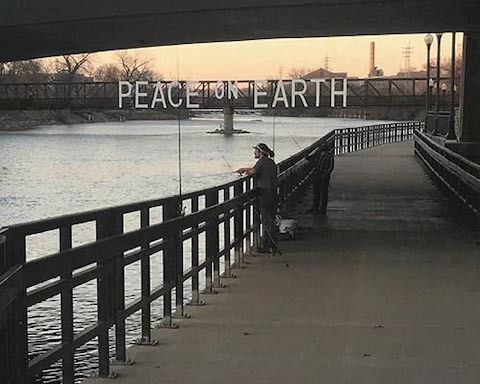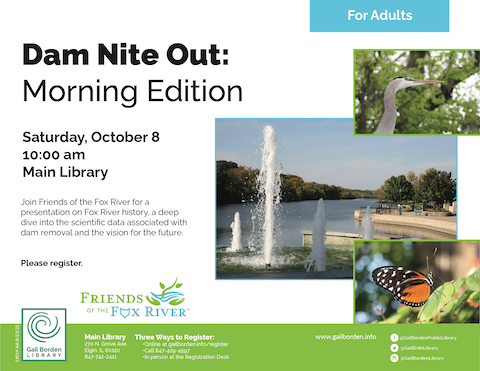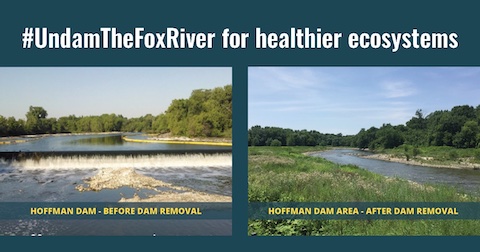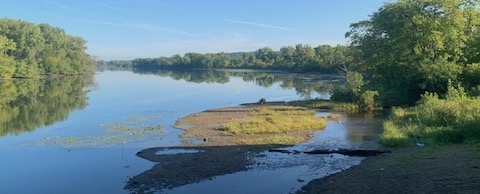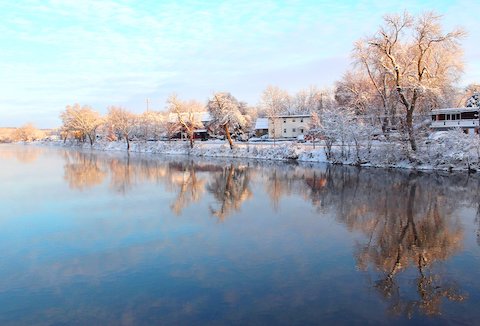December’s holiday season brings friends, family, and others together to celebrate a joyful time of gathering, feasting, and sharing gifts. It is a time of kinship and community. We openly welcome each other into our spaces. We set aside differences and focus on our commonalities. A sense of community helps us thrive spiritually, and we envision a sense of peace. Living together in the Fox River Watershed has forged us into a community. That community is shared by more than a million residents, who all live downstream from someone else. The holidays are a time to celebrate traditions, but also to develop new ones when necessary. The Fox River’s dams are a tradition we have had our whole lives, but they have outlived their usefulness. It is time to restore our river’s continuity.
Impaired Water Status
The impaired statusof the Illinois portion of the Fox River has brought new interest in exploring ways to restore water quality and habitat. The impaired status designation required the Illinois Environmental Protection Agency to develop a recovery plan and initiated the creation of the Fox River Study Group (FRSG) in 2002. After over a decade of intensive research, in 2015 the FRSG recommended the removal of phosphorous through enhanced wastewater treatment processes. As a result, over $150,000,000 has been invested by the local municipal facilities to achieve that goal. After further research, dam removal was the FRSG recommendation in 2022, but this did not immediately register much attention in the public sector.
Disaster Relief
In September, The US Army Corps of Engineers (ACOE) issued a local press release explaining their Tentatively Selective Plan (TSP) calling for the removal of nine dams in Kane County. The intent is to restore the habitat and water quality of a 40-mile stretch of the Fox River within the impairment area. Much research by several different agencies and dam removal examples have demonstrated that this technique is highly effective, and an economic bargain compared to additional phosphorous removal. The incredible addition is that it will be supported by federal and state funding. For the dam removal advocates, this was what we had been waiting for 30 years. Essentially, dam removal was disaster relief for the Fox River, similar to how the Federal Emergency Management Agency (FEMA) offers to help communities recover.
Dams Dividing Ourselves
The ACOE was on a fast track with the TSP sharing. Almost instantly, proponents were encouraged, and opponents were awakened and defensive. Three public meetings in three days drew over 700 people, many offering a 3-minute comment. That was followed by a 60-day comment period that resulted in 1200 submissions. Both sides mobilized their messaging. Like so many facets of our current culture, we have divided over a single issue. For me personally, this situation has strained a few relationships with riverfront property owner friends. But we are respectful friends and maintain our relationship. We all love the Fox River, but experience and appreciate it in different ways.
Telling the Story
Friends of the Fox River (FOTFR) was founded and continues to be a voice for the Fox River. That includes protecting against threats, maintaining protection measures, and restoring habitat. Restoration has included trash cleanups, natural area work removing invasive species, planting native species, and advocating for dam removal. The latter has always been a contentious journey with rather meager progress. Discussions on dam removal have a long local history of misunderstanding, disinformation, and fear of change. The dams have been there our entire lives, so they seem like important fixtures. To discuss these issues, Friends of the Fox River held community events called Dam Nite Out in Elgin, St. Charles, Batavia, Aurora, and two in Carpentersville last year. During these gatherings, attendees congregated at their respective local dams to learn about the natural and cultural history associated with each dam site. The group then reconvened with food and beverages to enjoy a presentation on the science of dam removal and an opportunity for questions. All six were well attended and follow-up surveys showed that nearly all the attendees left in favor of removing their dams.
The Long Wait
The ACOE will offer responses to the public comments and questions in December. Discussions with the nine communities with dams are ongoing with the ACOE. By April, the ACOE will request non-binding letters of interest from the communities. The ACOE will take those letters to our representatives in Washington to secure funding for the dam removals.
Unfortunately, this is a slow process, and two years from now the ACOE will be beginning additional engineering research, feasibility, and legal agreements for the specifics addressing each dam situation. Ultimately, it will be in 2026 that the reality of dam removal will culminate. Then in 2027, the celebration of river restoration will begin.
Common Ground
The intense focus on dam removal last fall has divided some, but it has demonstrated that we are also united. It was clear that all the public comments and probably the following 1200 written submissions were passionate pleas for their cherished relationship with the Fox River. We have different perspectives, but we all value the Fox River. Just as we are entering a season of coming together in search of peace, we should too, as Friends of the Fox River. Dam removal is one restoration technique. FOTFR welcomes all our Friends to join us throughout the coming year as we work to protect and restore water quality and habitat through clean-ups, native landscaping, and a long list of other techniques. Together, WE Keep on Fixin’ the Fox.

